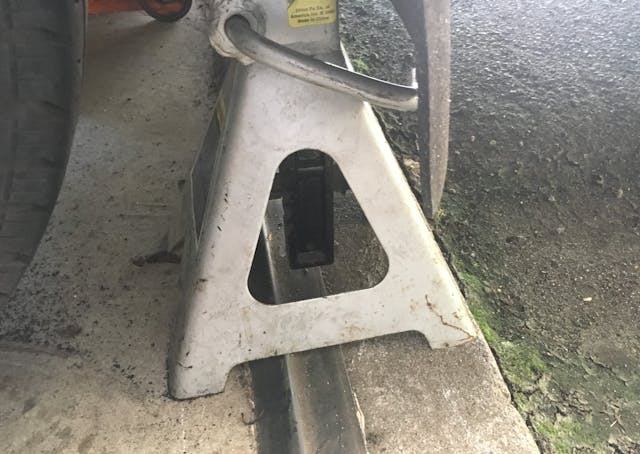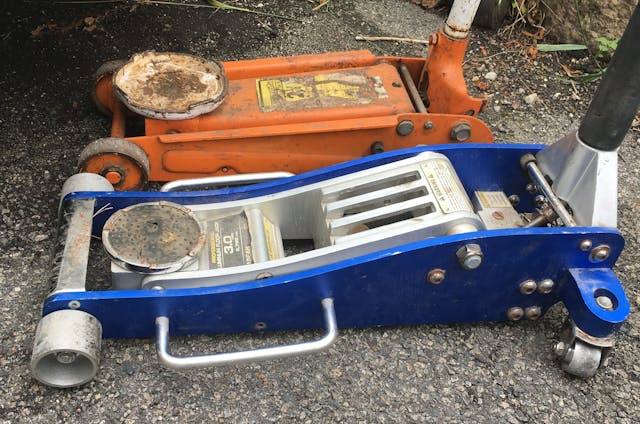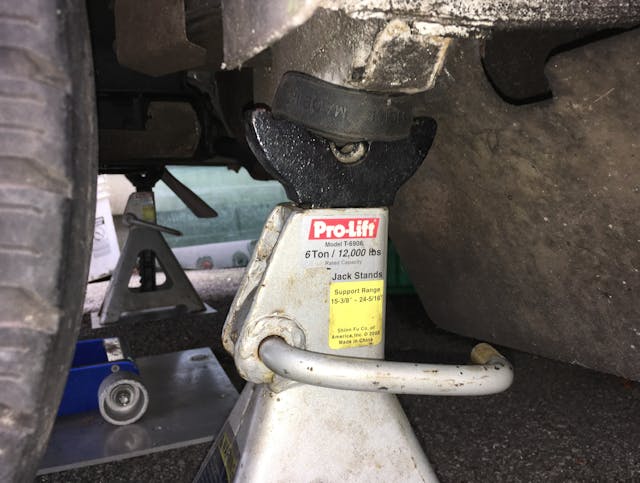Jacking up a small RV is harder than you’d think

A few weeks ago, I wrote a piece about safety requirements for using floor jacks and jack stands. In it, I stressed the importance of:
- Always using a jack and stands rated for the weight of the vehicle (e.g., don’t lift a truck with equipment made only to lift a small car)
- Only lifting on a hard level surface (e.g., concrete, not asphalt)
- Always double-jacking the vehicle (leaving the floor jack in place once the vehicle is resting securely on the stands).
I didn’t expect to run into all three of these issues when trying to do a little work on my little RV.
As I’ve written, my wife and I own this 1996 Winnebago Rialta. It’s very small, as RVs go—its full length is 20.5 feet, just 20 inches longer than a full-sized Chevy Suburban. It’s actually a Volkswagen Eurovan with a Winnebago camper body on the back, so its running gear is all VW Eurovan. Because of that I don’t really think of it as an RV, in terms of size and weight. However, when you have to work on it, there’s no getting around the fact that it is what it is, an RV.
Two years ago, I wrote that the camper body is just a little too tall to fit in my garage, however the Eurovan’s sloped front makes it so you can edge the nose just far enough in to be able to lift it, slip jack stands beneath it, and have the jacks rest securely on my concrete garage floor. I successfully employed this technique to do the front brakes, but I’ve been hesitant to do it again, as it blocks all the other vehicles in the garage.

So, as I wrote a few weeks ago, when I needed to find out what was making a racket in the Rialta’s serpentine belt path and fix it, I did it in the driveway with the Rialta at ground level and my body jammed beneath the front air dam. I was successful, but while I was under the car, I noticed that the boots on one of the lower ball joints was ripped. Since one of the “Big Seven” things likely to strand an older car is ball joint failure, I wanted to address it, or at the very least, jack up the car so I could check them for play.
And thus began “Project Safely Jack Up the RV on Asphalt.”
In the story I wrote about jack and stand safety, I quoted two methods of estimating what floor jack rating you need for a given vehicle. The “one wheel” method is to assume that, to safely jack up a single wheel to change a flat, you need a jack rated to 1/3 the weight of the vehicle. The second is the 75 percent method, cited by Tom and Ray Magliozzi (“Click and Clack” of Car Talk), in which the jack should be rated to at least 75 percent of the vehicle’s weight. So I looked up the weight of my ’96 Rialta.
Hmmm, 7000 pounds. More than I thought.

The “1/3 the vehicle weight to jack up one wheel” comes from adding a safety factor to 1/4 the weight, due to unequal weight distribution from the engine, but let’s just say for the moment that to lift just the nose to set it on stands, we assume half the weight. Half of 7000 pounds is 3500. I don’t currently have a real truck jack because I don’t currently have a real truck, but I do have an old battle axe of a steel Central Hydraulics floor jack, bought from Harbor Freight over 30 years ago when they were still called Harbor Freight and Salvage. It’s rated for 2 1/4 tons (4500 pounds). It didn’t quite meet Car Talk’s 75 percent rule of thumb (that would be 5250 pounds), but it was close. I probably used this jack to lift the Rialta’s nose and set it on stands two years ago.
The next issue was jack stands. No problem there. I did have a real set of truck stands—big and stable and rated to six tons.
Next was making the jacks-and-stands process safe on my asphalt driveway. The end of the driveway, where the RV resides, is nice and level, but it is asphalt and does have the inherent risk of jack and stand sinkage, with that risk amplified enormously as the weather heats up.
I looked in my basement and found a big piece of quarter inch aluminum plate, nearly three feet long and 18 inches wide, with a few holes drilled in it, that years ago I had saved from the scrap heap at my old engineering job. I thought about cutting it up to host the floor jack and both stands, but I realized that if I left it intact, its big size would make it perfect to allow the jack to be rolled easily. And since it was aluminum, not steel, it could easily be lifted and moved around. I left it intact and brought it outside to the RV.

So I just needed two 12 x 12-inch plates for the jack stands. I read online on places like garagejournal.com and grassrootsmotorsports.com, and the consensus seemed to be that, for supporting jack stands on asphalt or gravel, 1/2-inch plywood should be fine, 3/4-inch plywood should be beyond reproach, and plywood was used all the time at track events. Still, I envisioned that, once I had the mechanism for safe on-asphalt driveway repairs, I might take serious advantage of it and begin leaving vehicles “up” for days or weeks. My driveway slopes down, a lot of water runs to the end, and leaving a car up on plywood that’s been left in the rain gave me pause. I wanted the stands to be sitting on metal plates.
I looked on Amazon and found that 12 x 12 x 1/4-inch aluminum plates were about $30 each, and a pair of 1/8-inch plates could be ordered for about $30. I was, however, really itching to get the nose of the Rialta in the air, evaluate the ball joints, make a decision on ordering parts, and get any necessary shipping in motion before the weekend (you know how that goes). I looked online at Home Depot and found 16-gauge (1/16-inch) 12 x 12 galvanized steel plates for about $11 apiece. I drove to my local store to personally heft a plate, and it seemed thick and stiff enough to me. I came home with my prized plates and began to lift the RV.

I slid the big aluminum plate beneath the Rialta’s front crossmember, rolled my big old floor jack onto it, and jacked the nose of the RV up. But as I was beginning to place the jack stands behind the front wheels, I noticed that the nose of the RV was slowly sinking. Hmmm, I thought; that’s odd. I still use this floor jack all the time and haven’t ever seen this happen. I took a pair of Vise Grips, clamped them onto the jack handle, turned it clockwise to make sure I had the valve closed, and tried it again. It did the same thing—lifted, then slowly sank.
If you’re overloading a floor jack that has a bypass valve, as any modern jack does, it’s supposed to bleed off pressure as you try to lift; it’s not supposed to sink under weight. Whether this jack is too old to have a bypass valve, or whether it was simply losing pressure both because it’s reaching the end of its service lifetime and because I might have been overloading it, really doesn’t matter. When something like this happens, you stop.
I stopped.
Given the choice between ordering a new floor jack and waiting for it to arrive, trying to hastily borrow something from a friend, or rolling the dice and seeing what’s available used locally on Craigslist and Facebook Marketplace, I did the latter. To my delight, I unearthed an Arcan 3.0 (three ton) aluminum dual-pump jack for $75 in a neighboring town. These are about $250 new and well-reviewed on Amazon. With a 6000-pound capacity, it passes the 75 percent threshold for the 7000-pound RV. And its nose is a little lower than that of my old jack, which is nice. The venerable old Central Hydraulics jack will go to the scrap metal pile before it does anything else unexpected.

Initially I thought that the Arcan might check off another box—that with its aluminum construction, I might even be able to throw it in the Rialta and have it onboard in case my wife and I have a flat on the road. Unfortunately, even though all the big thick plate metal pieces appear to be aluminum, the jack is surprisingly heavy—58 pounds according to its listed specifications. Plus, one of the tradeoffs of the Rialta’s small size is a lack of cargo space; there are literally no external storage compartments on this RV, and the jack certainly can’t occupy precious floor space.
And, with that, my lift-safely-on-asphalt project was complete. The 6-ton jack stands are tall enough that I have them at their lowest possible setting, so there’s zero possibility of them slipping. The stands and the floor jack are sitting on metal plates. The 16-gauge plates under the stands are certainly deforming a bit under the weight, but as long as the corners of the bottoms of the jack stands don’t tear into the metal, I think that’s fine. Right now, the floor jack is de-pressurized, but when I crawl under the car, I’ll pump it back up until it makes contact with the subframe so the car is double-jacked.

This afternoon, before it started raining, I skooched under the RV long enough to inspect the ball joints. Turns out the boot on one of the upper ones is torn as well. I squeezed them with slip-joint pliers and tried to move them with a crowbar, and I didn’t feel any play. Nonetheless, I ordered all four lowers and uppers. The two repairs don’t actually overlap much, but I’ll probably at least knock off the lowers—the easier of the two—while I have the car up.
And more to the point, with the car up, I can, as Austin Powers said, give the undercarriage a good long how’s your father—look for leaks, squeeze all the cooling hoses to look for any that are soft and ready to tear, etc.
I’m going to feel very safe under this setup.
***
Rob Siegel’s new book, The Best Of The Hack MechanicTM: 35 years of hacks, kluges, and assorted automotive mayhem, is available on Amazon. His other seven books are available here, or you can order personally-inscribed copies through his website, www.robsiegel.com.

